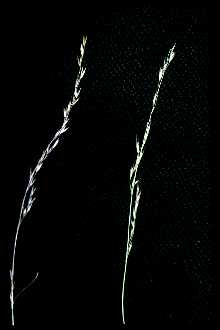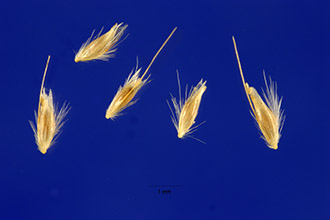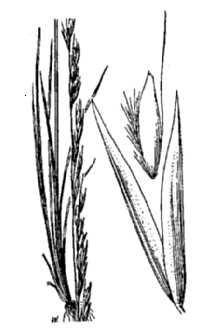Aira elongata Hook.
Scientific Name: Aira elongata Hook.

| General Information | |
|---|---|
| Usda Symbol | AIEL3 |
| Group | Monocot |
| Life Cycle | Perennial |
| Growth Habits | Graminoid |
| Native Locations | AIEL3 |
Plant Guide
Use a soil moisture meter to monitor the soil moisture where Aira elongata Hook. is planted.
Fact Sheet
Alternate Names
Another scientific name is Aira elongata.
Uses
Slender hairgrass is a moderate to fast growing native bunchgrass useful for erosion control along waterways, ditches, and streambanks, as well as on other seasonally wet or recently disturbed sites. It can also be sown as cover after logging in ravines and other moist forest areas. This species has potential as a nurse crop for slower establishing, longer lived species like California oatgrass (Danthonia californica) or other native prairie and woodland grasses and herbs. Forage value is fair to good prior to maturity. This is a versatile and underutilized native grass. It is also regarded as an attractive ornamental grass because of its fine texture, wispy seed heads, and golden color in summer.
Status
Please consult the PLANTS Web site and your State Department of Natural Resources for this plant’s current status (e.g. threatened or endangered species, state noxious status, and wetland indicator values).
Description and Adaptation
Adaptation
Adaptation
Dale Darris USDA NRCS Corvallis PMC Slender hairgrass is a moderate sized, fine textured, cool season grass, It is generally a biennial or short-lived perennial under most conditions, Stems (culms) are 40 to 80 (100) cm tall, Leaves are hair-like, less than 1,5 mm wide, and form a basal tuft, The open sheaths are smooth and auricles are absent, The panicle (flowerhead) is 5 to 25 (30) cm long, narrow with slender upward-pointing branches, and a pale green to purple color, This species occurs primarily from Alaska to California and east to Montana and New Mexico, Key to identification: The slender, upright to arching seed head and fine leaves are indicative of its common name, It should not be confused with tufted hairgrass (Deschampsia caespitosa) which is taller, coarser, and more robust, Use soil moisture sensors to measure the soil moisture of Aira elongata Hook.., In addition, the panicles of tufted hairgrass are more open and branching, and the leaves are broader and flatter than slender hairgrass, Annual hairgrass (Deschampsia danthonioides) is smaller and the panicle is also much broader and open compared to slender hairgrass, Because of the fine texture and small florets, it may loosely resemble a bentgrass (Agrostis sp,) without closer inspection, Relative abundance in the wild: Scattered to relatively common but rarely in large numbers, Slender hairgrass is occasionally found in drainage ways, seep areas, ditches, and damp open woods, as well as adjacent to moist pathways or other disturbed areas, Adaptation: Slender hairgrass can be found in wet meadows and along the margins of streams, ponds, and lakes, Habitat also includes moist slopes and the understory of open forests from lowland to alpine zones, It is also a component of coastal prairies, As a species of secondary plant succession, slender hairgrass re-establishes after logging in associated forest communities, It is found on fine sandy or gravelly soils as well as heavier soil types, This species tolerates full sun to partial shade,
Establishment
There is no seed dormancy and slender hairgrass establishes readily by sowing in the fall or early spring. Removal of surface hairs (pubescence) on the seed aids in further seed cleaning as well as sowing with a drill. There are approximately 2,300,000 seeds/lb (+/- 20%). Each pound of live seed sown per acre applies about 54 seeds per square foot. Based on seed size and seedling vigor, suggested seeding rates are 2-4 lbs/ac when sown alone. Higher rates may be required when broadcasting to achieve full stands under more difficult conditions.
Management
Information on the management of this species is lacking. Given its short-lived nature, grazing must be deferred during flowering and seed set every other year for stand regeneration. Its ability to easily volunteer on moist, disturbed ground and readily produce seed makes it a candidate for moist soil management of wetland habitat for waterfowl, shorebirds, and other wildlife.
Plant Traits
Growth Requirements
| Temperature, Minimum (°F) | -38 |
|---|---|
| Adapted to Coarse Textured Soils | Yes |
| Adapted to Fine Textured Soils | Yes |
| Adapted to Medium Textured Soils | Yes |
| Anaerobic Tolerance | Medium |
| CaCO3 Tolerance | Medium |
| Cold Stratification Required | No |
| Drought Tolerance | Medium |
| Fertility Requirement | Low |
| Fire Tolerance | High |
| Frost Free Days, Minimum | 90 |
| Hedge Tolerance | None |
| Moisture Use | Low |
| pH, Maximum | 7.8 |
| pH, Minimum | 6.0 |
| Precipitation, Maximum | 24 |
| Precipitation, Minimum | 10 |
| Root Depth, Minimum (inches) | 8 |
| Salinity Tolerance | Medium |
| Shade Tolerance | Intolerant |
Morphology/Physiology
| After Harvest Regrowth Rate | Slow |
|---|---|
| Toxicity | None |
| Shape and Orientation | Erect |
| Nitrogen Fixation | None |
| Resprout Ability | No |
| Active Growth Period | Spring and Summer |
| Bloat | None |
| C:N Ratio | Medium |
| Coppice Potential | No |
| Fall Conspicuous | No |
| Fire Resistant | No |
| Flower Color | Yellow |
| Flower Conspicuous | No |
| Foliage Color | Green |
| Foliage Porosity Summer | Porous |
| Foliage Texture | Coarse |
| Low Growing Grass | Yes |
| Lifespan | Short |
| Leaf Retention | No |
| Known Allelopath | No |
| Height, Mature (feet) | 3.0 |
| Growth Rate | Moderate |
| Growth Form | Bunch |
| Fruit/Seed Conspicuous | No |
| Fruit/Seed Color | Brown |
| Foliage Porosity Winter | Porous |
Reproduction
| Vegetative Spread Rate | Moderate |
|---|---|
| Small Grain | No |
| Seedling Vigor | Medium |
| Seed Spread Rate | Moderate |
| Seed per Pound | 1860000 |
| Fruit/Seed Persistence | No |
| Propagated by Tubers | No |
| Propagated by Sprigs | No |
| Propagated by Sod | No |
| Propagated by Seed | Yes |
| Propagated by Corm | No |
| Propagated by Container | No |
| Propagated by Bulb | No |
| Propagated by Bare Root | No |
| Fruit/Seed Period End | Summer |
| Fruit/Seed Period Begin | Spring |
| Fruit/Seed Abundance | High |
| Commercial Availability | Routinely Available |
| Bloom Period | Late Spring |
| Propagated by Cuttings | No |
Suitability/Use
| Veneer Product | No |
|---|---|
| Pulpwood Product | No |
| Protein Potential | Low |
| Post Product | No |
| Palatable Human | No |
| Palatable Graze Animal | Low |
| Palatable Browse Animal | Low |
| Nursery Stock Product | No |
| Naval Store Product | No |
| Lumber Product | No |
| Fodder Product | Yes |
| Christmas Tree Product | No |
| Berry/Nut/Seed Product | No |


